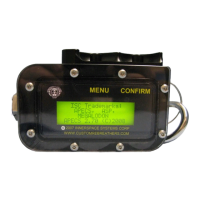______________________________________________________________________________________
Revision NEW APECS™ 2.7 6 of 19
Date: 10 July 2008
APECS ™ OPERATIONAL
INSTRUCTIONS (v. 2.7)
page for the
Megalodon. The diver may access SYSTEM MONITOR during the dive to
monitor the sensor mv (sensor millivolts) and the BATTERY: NORM and LOAD
voltages (LOAD voltage on primary handset only). The NORM battery indicator
shows the drop in voltage when there is no load on the battery. The LOAD
reading is the battery load for when the solenoid is activating and putting a strain
on the battery, it is this indicator that the diver needs to be aware of for battery
performance.
WARNING! The lower limit is 5.2 volts and the diver must replace the
battery!
The maximum battery voltage indication is 10.0 volts. Early low battery
indicators are the failure of the backlight to turn on when a button is pushed to
see the display in low light conditions, a second indicator is the LOW BATT
indicator flashing on the primary handset main page and on the BL ENABLE
page, the KEEP BACKLITE ON setting will be ignored in this state. The LOW
BATT warning is triggered by a LOAD voltage of 5.2v or less, if the LOAD
voltage rises above 5.2v when the solenoid is not firing the LOW BATT indicator
will display only while the solenoid is firing, in both cases the back light is
disabled and will not be available until the system power is reset. If the primary
battery voltage should drop below ~4.5v the handset display will “go blank”, the
processor will continue to operate, however the solenoid will cease “firing”. If this
occurs, the diver will need to reference the secondary display and HUD to “fly”
the system manually.
DANGER! If the system is configured with an Isolation board and third
party electronics, voltage below ~4.5v will cause the handset to “go blank”,
the solenoid will cease firing and the HUD will cease to work. PO2 must be
monitored on the third party system.
DANGER! Terminate the dive as soon as practical considering
decompression and other operational factors. Both conditions warrant the
battery to be replaced prior to the next dive!
In most diving scenarios, the diver has adequate time to exit the water without
sacrificing safety.
The sensor mv is an indicator of sensor degradation (health), the diver may see
how the sensor is performing at all times during the pre-dive, dive, and post-dive,
operations. The diver should record the information on the pre-dive/post-dive
check sheet to monitor sensor life and performance over time. Normal sensor
mv is 8 to 13.5 in air at sea level, 25°c. Sensor mv output will be less at higher

